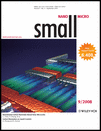Nanoporous Structures: Smaller is Stronger†
Gang Ouyang
School of Electrical & Electronic Engineering Nanyang Technological University Singapore, 639798 (Singapore)
College of Physics and Information Science Hunan Normal University Changsha, 410081 (P.R. China)
Search for more papers by this authorCorresponding Author
Guowei Yang
State Key Laboratory of Optoelectronic Materials and Technologies Institute of Optoelectronic and Functional Composite Materials School of Physics, Science, and Engineering, Zhongshan University Guangzhou, 510275 (P.R. China)
State Key Laboratory of Optoelectronic Materials and Technologies Institute of Optoelectronic and Functional Composite Materials School of Physics, Science, and Engineering, Zhongshan University Guangzhou, 510275 (P.R. China)Search for more papers by this authorChangqing Sun
School of Electrical & Electronic Engineering Nanyang Technological University Singapore, 639798 (Singapore)
Search for more papers by this authorWeiguang Zhu
School of Electrical & Electronic Engineering Nanyang Technological University Singapore, 639798 (Singapore)
Search for more papers by this authorGang Ouyang
School of Electrical & Electronic Engineering Nanyang Technological University Singapore, 639798 (Singapore)
College of Physics and Information Science Hunan Normal University Changsha, 410081 (P.R. China)
Search for more papers by this authorCorresponding Author
Guowei Yang
State Key Laboratory of Optoelectronic Materials and Technologies Institute of Optoelectronic and Functional Composite Materials School of Physics, Science, and Engineering, Zhongshan University Guangzhou, 510275 (P.R. China)
State Key Laboratory of Optoelectronic Materials and Technologies Institute of Optoelectronic and Functional Composite Materials School of Physics, Science, and Engineering, Zhongshan University Guangzhou, 510275 (P.R. China)Search for more papers by this authorChangqing Sun
School of Electrical & Electronic Engineering Nanyang Technological University Singapore, 639798 (Singapore)
Search for more papers by this authorWeiguang Zhu
School of Electrical & Electronic Engineering Nanyang Technological University Singapore, 639798 (Singapore)
Search for more papers by this authorThis work was supported by the National Natural Science Foundation of China (10747129, 50525206, and U0734004), the Ministry of Education (106126), and the Hunan Normal University (070622).
Graphical Abstract
It's what's inside that counts! Nanoporous materials with large internal surface area have been extensively employed as host materials in nanotechnology. Since the lower co-ordination of atoms of nanoporous structures can lead to the redistribution of electronic charge and change the cohesive energy of single atoms in the matrix (see image), the mechanical responses differ from those of atoms in the bulk counterpart.
References
- 1 M. Gershow, J. A. Golovchenko, Nature Nanotech. 2007, 2, 775– 779.
- 2 D. Stein, Nature Nanotech. 2007, 2, 741– 742.
- 3 F. Buyukserin, M. C. Kang, C. R. Martin, Small 2007, 3, 106– 110.
- 4 J. D. Uram, K. Ke, A. J. Hunt, M. Mager, Small 2006, 2, 967– 972.
- 5 M. Lahav, T. Sehayek, A. Vaskevich, I. Rubinstein, Angew. Chem. Int. Ed. 2003, 42, 5576– 5579.
- 6 S. Chan, S. R. Horner, P. M. Fauchet, B. L. Miller, J. Am. Chem. Soc. 2001, 123, 11797– 11798.
- 7 G. Ouyang, X. Tan, G. W. Yang, Phys. Rev. B 2006, 74, 195408.
- 8 G. Ouyang, X. L. Li, X. Tan, G. W. Yang, Phys. Rev. B 2007, 76, 193406.
- 9 G. Ouyang, X. L. Li, G. W. Yang, Appl. Phys. Lett. 2008, 92, 051902.
- 10 Z. Gaburro, N. Daldosso, L. Pavesi, G. Faglia, C. Baratto, G. Sberveglieri, Appl. Phys. Lett. 2001, 78, 3744– 3746.
- 11 N. Ramakrishnan, V. S. Arunachalam, J. Am. Ceram. Soc. 1993, 76, 2745– 2752.
- 12 R. G. Munro, J. Am. Ceram. Soc. 2001, 84, 1190– 1192.
- 13 E. A. Dean, J. A. Lopez, J. Am. Ceram. Soc. 1983, 66, 366– 370.
- 14 Y. Z. Povstenko, J. Mech. Phys. Solids 1993, 41, 1499– 1514.
- 15 H. L. Duan, J. Wang, B. L. Karihaloo, Z. P. Huang, Acta Mater. 2006, 54, 2983– 2990.
- 16 X. F. Zhu, J. Appl. Phys. 2006, 100, 034304.
- 17 G. Ouyang, X. Tan, M. Q. Cai, G. W. Yang, Appl. Phys. Lett. 2006, 89, 183104.
- 18 C. Q. Sun, B. K. Tay, X. T. Zeng, S. Li, T. P. Chen, J. Zhou, H. L. Bai, E. Y. Jiang, J. Phys.: Condens. Matter 2002, 14, 7781– 7795.
- 19 J. Wang, H. L. Duan, Z. Zhang, Z. P. Huang, Int. J. Mech. Sci. 2005, 47, 701– 718.
- 20 R. M. Christensen, K. H. Lo, J. Mech. Phys. Solids 1979, 27, 315– 330.
- 21 C. Q. Chen, Y. Shi, Y. S. Zhang, J. Zhu, Y. J. Yan, Phys. Rev. Lett. 2006, 96, 075505.
- 22 A. Mathur, J. Erlebacher, Appl. Phys. Lett. 2007, 90, 061910.
- 23 C. Kittel, Introduction to Solid State Physics, 6th ed. Wiley, New York 1986.
- 24 X. F. Wu, Yuris, A. Dzenis, J. Appl. Phys. 2007, 102, 044306.
- 25 Y. A. Chang, L. M. Pike, C. T. Liu, A. R. Bilbrey, D. S. Stone, Intermetallics 1993, 1, 107– 115.
- 26 J. Yan, X. Ma, W. Zhao, H. Tang, C. Zhu, S. Cai, ChemPhysChem 2005, 6, 2099– 2113.
- 27 J. Biener, A. M. Hodge, J. R. Hayes, C. A. Volkert, L. A. Zepeda-Ruiz, A. V. Hamza, F. F. Abraham, Nano Lett. 2006, 6, 2379– 2382.
- 28 J. Biener, A. M. Hodge, A. V. Hamza, L. M. Hsiung, J. H. Satcher, J. Appl. Phys. 2005, 97, 024301.
- 29 R. Dingreville, J. Qu, M. Cherkaoui, J. Mech. Phys. Solids 2005, 53, 1827– 1854.
- 30 S. Parida, D. Kramer, C. A. Volckert, H. Rosner, J. Erlebacher, J. Weissmuller, Phys. Rev. Lett. 2006, 97, 035504.
- 31Available from http://www.webelements.com.
- 32 J. H. Li, Y. Kong, H. B. Guo, S. H. Liang, B. X. Liu, Phys. Rev. B 2007, 76, 104101.





